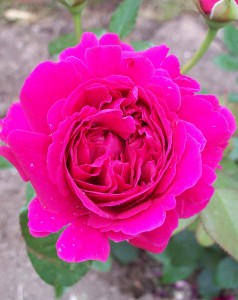Adventures in Organic Gardening
By Laura Sileo-Lepkyj
I generally practice a survival-of-the-fittest approach to gardening, but I admit to pampering my roses a bit. I figure they deserve it for the joy they bring me. Few other flowers make me literally tear up from their beauty.
I planted my roses last spring. I have mostly English roses because I love the heavy fragrance and voluptuously full blossoms. The exceptions are my Grandiflora “Dream Come True” and two Polyantha “The Fairy” roses.
Here are some tips on growing roses organically:
Selection of roses
First, the selection of the variety is important. For the average gardener it makes no sense to struggle to keep a rose if it is known to have poor disease resistance. I have selected varieties that have excellent to good disease resistance.

This quality is hardly written in stone though, and can vary from year to year. With last summer’s cool temperatures and excessive rain, “Benjamin Britten” looked rather yellow and spotty (black spot). This year he looks fantastic and “Golden Celebration” has the most trouble.
Both this year and last, “The Fairy” has been outstanding even though she is not placed in locations with good air circulation, which is recommended to help prevent fungal diseases such as black spot. Another bonus to “The Fairy” is that Polyantha roses are almost always grown on their own root, not grafted onto rootstock, and she is in continuous bloom from early July through most of October. Not periods of rebloom, continuous bloom. It is an outstanding rose!
Fertilization
I prefer Epsoma’s Rose Tone product for fertilization, which I do on the first of the month from May to September.There are recommendations on the bag for the proper amount to use. On a day this past spring when I was feeling particularly mathematically inclined, I calculated that one heaping hand trowel of Rose Tone is the approximate amount to use per bush per month. I sprinkle Rose Tone around the base of the plant and lightly scratch it into the dirt.

About half of the time I moisten it as well, being careful not to get water all over the leaves. I only water half of the time because it’s totally a matter of convenience for me. Is the hose already pulled out because I was topping off the pond water or watering containers? Then yeah, maybe I’ll water in the fertilizer. Is the hose neatly wound on its holder and remarkable kink-free? Best not to disturb it.
Weeding
Recently I bit the bullet and really cleaned up the rose garden. It was a day-long project and I always seem to pick exceedingly hot days to try these endeavors, but it was well worth it.
Once I weeded—extensively—and dug and straightened the edges, I placed an inconspicuous green edging around the borders to keep weeds and grass out so that I would not have to repeat this process on a yearly basis.
I discovered that Preen comes in an organic formulation that consists of pure corn gluten to prevent seed germination. Organic Preen costs just $1 more than its non-organic cousin, dispelling the myth that it’s super-expensive to garden organically. I applied the Preen to the soil, topped things with a good two inches of mulch, and Preened again. So far, about a month and a half later, I’m happy to say very few weeds have come up.
Organic fungicide and pesticide

The last part to the roses’ spa day is the application of an organic fungicide on the first of the month.
There are numerous brands readily available. For the same price as synthetic sprays, you can find organic fungicides or fungicide-pesticide combos.
Personally, I buy the fungicide spray and make my own pesticide spray to use as needed when I spot aphids. Here’s how you do it: Fill a sprayer bottle from the dollar store with water and add a few drops of liquid dish soap and cooking oil. The water makes it readily sprayable and the oil and soap cling to the aphids and clog their spiracles, the insects’ breathing organs. A few sprays of this home remedy kills the aphids almost instantly. Give it a try; it’s effective and cheap!




Laura’s garden was on the Amherst Garden Walk.
Best,
Connie
I love roses but like everyone else, gets frustrated about how to grow them and with problems with Japanese beetles, etc. Laura’s method seems what I need. Was her garden in the Open Garden tour? I would love to see her roses and talk to her more about it. How can I get hold of her? Thanks Connie, Jaime